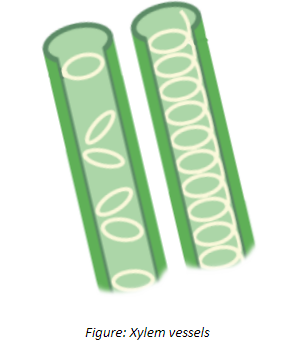
Which one of the following contains obliterated central lumen?
A. Tracheids
B. Xylem fibres
C. Vessels
D. Xylem parenchyma
Answer
503.4k+ views
Hint: Vascular tissues are responsible for the upward transfer of water and nutrients from the roots.
Complete answer:
Xylem fibres have highly thickened lignified walls and obliterated central lumen. The flow of substances takes place via the central region or lumen of these tubes. Xylem fibres are characterized by the presence of nonliving sclerenchyma cells that lose protoplasts at maturity. These sclerenchyma cells are elongated in shape with tapering ends. There are two types of xylem fibres:
Fibres tracheids:
-They have invasive growth.
-The bordered pits are less developed.
-They are shorter in length with the thick cell wall.
-They have a slit-like inner aperture.
Libriform fibres:
-The cell wall of these fibres has cellulosic deposition and hence, appears as gelatinous in cross-section.
-They possess simple pits on their wall.
-It is characterized by the presence of elongated cells and thick walls.
The function of xylem fibres:
-The main function of xylem fibres is to perform the function of mechanical support.
-They help in the storage of water in plants.
-They possess dead cells that provide support to the water-conducting tissues.
-It helps in conduction of water and minerals in an upward direction from root to leaves.
-Sometimes starch is also stored in the xylem fibres and xylem parenchyma.
So, the correct answer is ‘xylem fibres’.
Note: Fibres may present in both primary and secondary xylem but they are much less in primary xylem.
In secondary xylem, fibres arise from fusiform initials of cambium while in primary xylem it originates from procambium.

Complete answer:
Xylem fibres have highly thickened lignified walls and obliterated central lumen. The flow of substances takes place via the central region or lumen of these tubes. Xylem fibres are characterized by the presence of nonliving sclerenchyma cells that lose protoplasts at maturity. These sclerenchyma cells are elongated in shape with tapering ends. There are two types of xylem fibres:
Fibres tracheids:
-They have invasive growth.
-The bordered pits are less developed.
-They are shorter in length with the thick cell wall.
-They have a slit-like inner aperture.
Libriform fibres:
-The cell wall of these fibres has cellulosic deposition and hence, appears as gelatinous in cross-section.
-They possess simple pits on their wall.
-It is characterized by the presence of elongated cells and thick walls.
The function of xylem fibres:
-The main function of xylem fibres is to perform the function of mechanical support.
-They help in the storage of water in plants.
-They possess dead cells that provide support to the water-conducting tissues.
-It helps in conduction of water and minerals in an upward direction from root to leaves.
-Sometimes starch is also stored in the xylem fibres and xylem parenchyma.
So, the correct answer is ‘xylem fibres’.
Note: Fibres may present in both primary and secondary xylem but they are much less in primary xylem.
In secondary xylem, fibres arise from fusiform initials of cambium while in primary xylem it originates from procambium.

Recently Updated Pages
Master Class 11 Economics: Engaging Questions & Answers for Success

Master Class 11 Business Studies: Engaging Questions & Answers for Success

Master Class 11 Accountancy: Engaging Questions & Answers for Success

Master Class 11 English: Engaging Questions & Answers for Success

Master Class 11 Computer Science: Engaging Questions & Answers for Success

Master Class 11 Maths: Engaging Questions & Answers for Success

Trending doubts
Which one is a true fish A Jellyfish B Starfish C Dogfish class 11 biology CBSE

State and prove Bernoullis theorem class 11 physics CBSE

1 ton equals to A 100 kg B 1000 kg C 10 kg D 10000 class 11 physics CBSE

In which part of the body the blood is purified oxygenation class 11 biology CBSE

One Metric ton is equal to kg A 10000 B 1000 C 100 class 11 physics CBSE

Difference Between Prokaryotic Cells and Eukaryotic Cells




